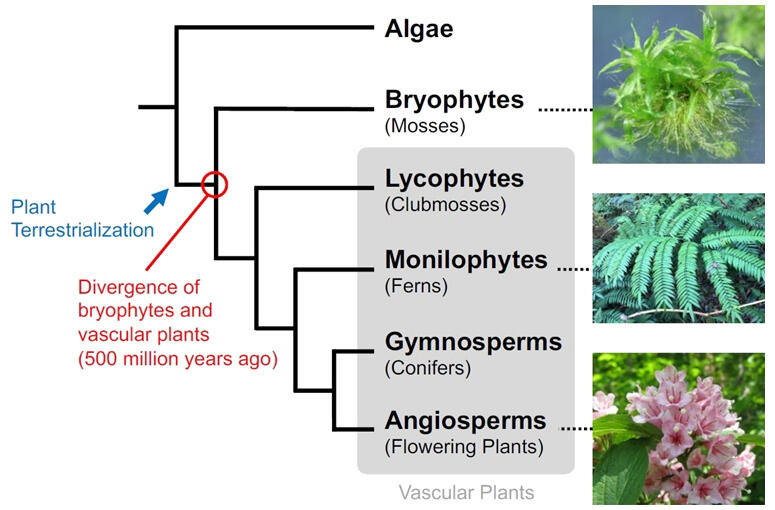Plants can grow vigorously because they have pluripotent stem cells in the meristems at the tips of their stems and roots. Pluripotent stem cells are capable of generating various types of cells and underlie the growth of branches, production of leaves, and other organs throughout plants' lives. However, it has not been fully understood how the nature of pluripotent stem cells in plants is determined. A research group led by Assistant Professor Yuki Hata and Professor Junko Kyozuka of the Graduate School of Life Sciences at Tohoku University analyzed the mechanisms determining the properties of stem cells in a bryophyte, which has the smallest meristem comprised of only one pluripotent stem cell. The results showed that stem cell divide into two cells, of which one is characterized by the accumulation of cytokinins, a class of phytohormones, and remains a stem cell, whereas the other is characterized by the accumulation of PpTAW proteins, which promote differentiation into leaves and other tissues. Bryophytes are a group of plants that have separated from the division Tracheophyta (vascular plants) to which angiosperms belong, approximately 500 million years ago. Cytokinins and PpTAW also regulate the development of meristems in angiosperms. Thus, these factors appear to be common stem cell regulators since 500 million years ago. This study was published in Science Advances.

Provided by Tohoku University
In Physcomitrium patens, a moss commonly used for research, branching cells arising from a single cell-row filamentous tissue called the protonema become apical cells when they receive signals and form the apical meristem after several regular divisions. In the center of the apical meristem, apical cells are found as tetrahedral cells, which repeat oblique divisions in a spiral pattern to send differentiating cells laterally. One differentiating cell always produces a leaf and its basal stalk tissue, forming a plant body typical of bryophytes called the gametophore. Thus, P. patens contains stem cells that are clearly distinct from non-stem cells and simple tissue structures as its unique characteristics. Bryophytes are a sister taxon to tracheophytes and were separated from the phyletic group containing angiosperm approximately 500 million years ago. Therefore, they represent an excellent research target for clarifying the molecular mechanisms and common principles of stem cell properties in terrestrial plants as a whole. Therefore, P. patens was used to investigate how apical cells are maintained.
First, the group focused on the function of transcription factors belonging to the Arabidopsis LSH Oryza G1 (ALOG) family, which regulate the growth of the shoot apical meristem in angiosperms. Recent studies have shown that ALOG proteins are necessary for the maintenance of the shoot apical meristem in P. patens, suggesting that ALOG proteins are involved in the maintenance of apical cells. In the P. patens genome, four genes encoding ALOG transcription factors were identified, which were named PpTAW1−PpTAW4. The localization patterns showed that they were found locally in almost all tissues in the protonemata and gametophores. Interestingly, PpTAW1−PpTAW4 were not specifically localized in apical cells. Moreover, examinations of the promoter activity of the PpTAW2 gene revealed that, unlike protein localization, mRNA transcription was also observed in apical cells. It is indicated that the localization of PpTAW proteins is suppressed specifically in apical cells by post-transcriptional regulation.
The localization patterns of PpTAW proteins suggest that stem cell factors are present specifically in apical cells and suppresses the accumulation of PpTAW proteins. Thus, cytokinins, phytohormones known to promote apical cell formation, were added to the plant body. Although the amount of PpTAW mRNA was not affected, the accumulation of PpTAW protein was reduced. Furthermore, the introduction of the Two Component System version 2 (TCSv2) reporter, a cytokinin sensor, into P. patens revealed the localization of strong cytokinin signals in the apical cells, contrary to the localization of the PpTAW proteins.
In addition, the expression pattern of the LONELY GUY (LOG) gene which encodes an enzyme for the biosynthesis of active cytokinins revealed the localization of strong LOG expression in apical cells, supporting the TCSv2 reporter results. These results indicate that cytokinins are stem cell factors that are localized in apical cells, promote apical cell characteristics, and inhibit the accumulation of PpTAW proteins.
Next, the research group examined the effect of inhibiting the PpTAW function on growth. When a fusion protein containing the transcriptional repressor domain SRDX added to the PpTAW2 protein was overexpressed to inhibit the transcriptional activation of PpTAW, abnormal tissue differentiation from the shoot apical meristem and the formation of irregular cell masses were observed. These irregular cell masses also exhibited the high TCSv2 reporter expression, indicating that their properties as differentiated cells were not well established. These results suggest that PpTAW promotes the differentiation of one daughter cell after apical cell division. On the other hand, the loss-of-function mutant in which all four PpTAW genes were knocked out showed abnormal cell growth and proliferation in some leaves but no major abnormalities in the development of the shoot apical meristem. It suggests the presence of differentiation-promoting factors other than PpTAW.
Finally, ectopic expression of PpTAW2 in the whole plant body, including apical cells, inhibited apical cell formation. This result further confirms that the PpTAW function promotes differentiation.
These findings suggest that apical cells are maintained by the following mechanisms. First, cytokinins are localized specifically in apical cells through the action of the cytokinin-activating enzyme LOG and promote stem cell characteristics simultaneously with inhibiting the localization of PpTAW through post-transcriptional regulation. Meanwhile, in differentiating cells, cytokinin levels are reduced, and PpTAW can be localized. PpTAW promotes differentiation and the formation of tissues, such as leaves and stems.
Journal Information
Publication: Science Advances
Title: Cytokinin and ALOG proteins regulate pluripotent stem cell identity in the moss Physcomitrium patens
DOI: 10.1126/sciadv.adq6082
This article has been translated by JST with permission from The Science News Ltd. (https://sci-news.co.jp/). Unauthorized reproduction of the article and photographs is prohibited.




